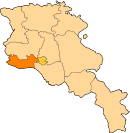Aknashen
40°05′45″N 44°17′10″E / 40.09583°N 44.28611°E
Aknashen Ակնաշեն | |
|---|---|
| Coordinates: 40°05′45″N 44°17′10″E / 40.09583°N 44.28611°E | |
| Country | Armenia |
| Marz (Province) | Armavir |
| Population (2011) | |
• Total | 1,569[1] |
| Time zone | UTC+4 ( ) |
| • Summer (DST) | UTC+5 ( ) |
Aknashen (Armenian: Ակնաշեն, also Romanized as Aknachen; until 1978, Khatunarkh Verin, Verin Khatunarkh, and Khatunarkh, also Russified as Verkhniy Khatunarkh) is a town in the Armavir Province of Armenia. The town's church is dedicated to Saint Bartholomew; nearby is a ruin of an 8th-century building.
Archaeology
[edit]Evidence from charred remains and crop processing residues in pisé have been discovered at the Neolithic settlements of Aratashen and Aknashen. These settlements are located close together.[2] Recently, an 8000-year old settlement was excavated at Aknashen[3]
Aknashen is located in the basin of the Sev Jur (Metsamor) River (fr:Metsamor (rivière)), at an altitude of 900m above sea level. In 1969–1982 it was excavated by R.M. Torosyan. The Late Neolithic “Aratashen-Shulaveri-Shomutepe” cultural layer is represented by Horizons II–V. This lies directly under the Chalcolithic layer, and dates to the first half of the 6th millennium BC.[4]
Obsidian geometric microliths have been discovered at Aknashen, which is somewhat unusual for Shulaveri-Shomu sites.
According to the excavators,
- "... the identified Horizon VII [at Aknashen], separated from the overlying horizons of the “Aratashen-Shulaveri-Shomutepe” culture by hiatus, and stratigraphically and chronologically preceding the Late Neolithic, is partially filling the gap between the Early Holocene sites and the settlements of the “Aratashen-Shulaveri-Shomutepe” culture."[5]
In recent research, the links of Aknashen with the Middle Kura Basin have become clear, as also the links with the Shulaveri–Shomu culture. The earliest Horizon VII started in 5950 BC. Some imported pottery was found there. Local pottery appears in Horizon V, around 5800 BC.[6]
See also
[edit]References
[edit]- ^ "Armavir (Armenia): Towns and Villages in Municipalities". www.citypopulation.de. Retrieved 2024-11-08.
- ^ Hovsepyan R. Willcox G. (2008). "The earliest finds of cultivated plants in Armenia: evidence from charred remains and crop processing residues in pisé from the Neolithic settlements of Aratashen and Aknashen". Vegetation History and Archaeobotany. 17: 63–71. doi:10.1007/s00334-008-0158-6. S2CID 66190451.
- ^ "8000-Year Old Settlement Excavated at Aknashen". 28 November 2017.
- ^ Ruben Badalyan and Armine Harutyunyan 2014, Aknashen—the Late Neolithic Settlement of the Ararat Valley: Main Results and Prospects for the Research. academia.edu
- ^ Ruben Badalyan and Armine Harutyunyan 2014, Aknashen—the Late Neolithic Settlement of the Ararat Valley: Main Results and Prospects for the Research. academia.edu
- ^ Lyonnet, Bertille (2022). "Ruben Badalyan, Christine Chataigner & Armine Harutyunyan (ed.). 2022. The Neolithic settlement of Aknashen (Ararat Valley, Armenia). Excavation seasons 2004–2015. Oxford: Archaeopress; 978-1-80327-003-6 eBook, Open Access". Antiquity. 96 (389): 1343–1345. doi:10.15184/aqy.2022.93. ISSN 0003-598X.
External sites
[edit]- Aknashen at GEOnet Names Server
- World Gazetteer: Armenia[dead link] – World-Gazetteer.com
- Report of the results of the 2001 Armenian Census, Statistical Committee of Armenia
- Kiesling, Brady (2005), Rediscovering Armenia: Guide, Yerevan, Armenia: Matit Graphic Design Studio
- Kiesling, Brady (June 2000). Rediscovering Armenia: An Archaeological/Touristic Gazetteer and Map Set for the Historical Monuments of Armenia (PDF). Archived (PDF) from the original on 6 November 2021.


